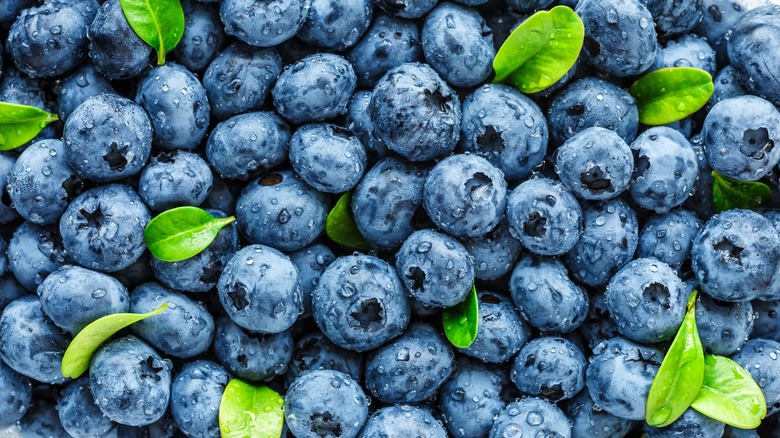Technically, Blueberries Aren't Blue. So How Do They Get Their Color?
Roses are red, blueberries are blue — actually, scientists are saying this isn't entirely true. You may think you know everything you need to know about blueberries, but you probably didn't know that these berries only appear to be blue due to a natural wax coating. In fact, according to a 2024 study published in Science Advances, not only does this wax look blue, it reflects ultraviolet light — which human eyes can't perceive, so you'll just have to imagine how cool it looks to birds that can. It makes sense, now, why robins always seem to pick out the best blueberries on the bush, because the ripest fruit quite literally glows to their little avian eyes.
The wax found on blueberries isn't unlike wax found on other blue-ish colored fruits. It's known as an epicuticular wax, which forms a crystal structure that refracts and reflects light. Have you ever noticed that when you cut a blueberry in half, the middle isn't blue at all? Neither is the skin, as it turns out; our brains just tell us it's blue because of how light interacts with the fruit's waxy coating before bouncing into our eyeballs.
Spectacular epicuticular wax
Blueberries develop their epicuticular wax to help protect them; it makes their skins water-resistant while keeping the fruits' natural water content inside the berries. The epicuticular wax also helps deter certain bugs and bacteria from infiltrating the berries, although, unfortunately, it doesn't keep rodents and birds from helping themselves to these sweet treats. The wax is formed with irregular crystalline structures that reflect light off the skin of the blueberries, making them appear blue.
As described in their 2024 study, researchers at Bristol's School of Biological Sciences removed this wax and recrystallized it onto card stock, which enabled them to observe it under a microscope. They found that this wax structure was not actually blue and that it threw off ultraviolet light. The thickness of this wax affects the color of each berry; for instance, you may find that some blueberries have a lighter, more purple or red hue — this is due to a lower concentration of wax.
The future of color
Rox Middleton is one of the researchers at Bristol's School of Biological Sciences who worked on the 2024 study. "The blue of blueberries can't be 'extracted' by squishing," she explained in a press release. "That was why we knew that there must be something strange about the color." In other words, if you've ever observed juice from blueberries, like in a blueberry vanilla "lemonade" shaved ice mocktail, you'll see that it's actually a deep red. Why is this information important? Because it opens up a new avenue for researchers to learn about natural pigments and colorants.
It's been speculated that, with more research, this epicuticular wax could be developed into revolutionary pigments that share blueberries' chromatic UV capabilities. Studying the crystalized wax can teach bioengineers how to harness its power and create coloring materials based on the natural characteristics of the blueberry: Imagine a room painted with blueberry skin paint. This is a revelation for biological scientists, but maybe a step back for blueberries. The blueberry PR team is going to have a heck of a time rebranding ultraviolet wax berries.


